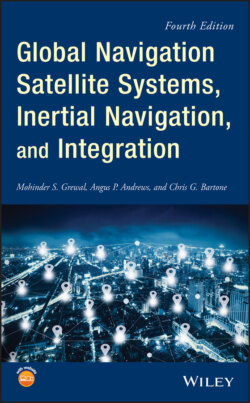Читать книгу Global Navigation Satellite Systems, Inertial Navigation, and Integration - Mohinder S. Grewal - Страница 43
1.3.2 Development Results 1.3.2.1 Inertial Sensors
ОглавлениеRotation sensors are used in INSs for keeping track of the directions of the sensitive (input) axes of the acceleration sensors – so that sensed accelerations can be integrated in a fixed coordinate frame. Sensors for measuring rotation or rotation rates are collectively called gyroscopes, a term coined by Jean Bernard Léon Foucault (1819–1868). Foucault measured the rotation rate of Earth using two types of gyroscopes:
1 What is now called a momentum wheel gyroscope (MWG), which – if no torques are applied – tends to keep its spin axis in an inertially fixed direction while Earth rotates under it.
2 The Foucault pendulum, which might now be called a vibrating Coriolis gyroscope (vibrating at about 0.06 Hz). It depends on sinusoidal motion of a proof mass and the Coriolis3 effect, an important design principle for miniature gyroscopes, as well.
Some of the physical phenomena used in the design of gyroscopes are listed in Table 1.1. Further explanation of the terminology is provided in Chapter 3.
Table 1.1 A sampling of inertial sensor types.
| What it measures | Sensor types | Physical phenomena | Implementation methods |
| Rotation (gyroscope) | Momentum wheel gyroscope (MWG) | Conservation of angular momentum | Angle displacement |
| Torque rebalance | |||
| Coriolis vibratory gyroscope (CVG) | Coriolis effect and vibration | Balanced (tuning fork) | |
| Wine glass resonance | |||
| Optical gyroscope | Sagnac effect | Fiber optic gyroscope (FOG) | |
| Ring laser gyroscope (RLG) | |||
| Acceleration (accelerometer) | Mass spring (fish example) | Stress in support | Piezoresistive |
| Piezoelectric | |||
| Surface acoustic wave | |||
| Vibrating wire in tension | |||
| Electromagnetic | Induction | Drag cup | |
| Electromagnetic force | Force rebalance | ||
| Pendulous integrating gyroscopic accelerometer (PIGA) | Gyroscopic precession | Angular displacement | |
| Torque rebalance | |||
| Electrostatic | Electrostatic force | Force rebalance |
What we call acceleration sensors or accelerometers actually measure specific force, equal to the physical force applied to a mass divided by the mass, solving f = ma for a, given f (the sensor input) and m (a known constant). Accelerometers do not measure gravitational acceleration, but can measure the force applied to counter gravity. A spring scale used in a fish market for measuring the mass m of a fish, for example, is actually measuring the spring force f applied to the fish by the spring for countering gravity, solving f = ma for m, given f (spring strain, proportional to force) and a (local gravity being countered).
The essential element of an accelerometers is its proof mass m, which is a known mass suspended within an enclosure with limited degrees of travel, with the enclosure affixed to the item to be navigated. However, there are other means for measuring the force required to keep the proof mass centered in its enclosure, some of which are listed in Table 1.1. The terminology used there will be elaborated upon in Chapter 3.
The relative input axis directions of all the inertial sensors in an INS is controlled by hard‐mounting them all to a common base, forming what is called an inertial sensor assembly (ISA) or IMU.4 This way, all the sensor input axes will have a fixed direction relative to one another. The ISA is essentially the “holy point” of inertial navigation, just as the receiver antenna is the holy point for GNSS navigation. It is the reference point for the navigation solution.
